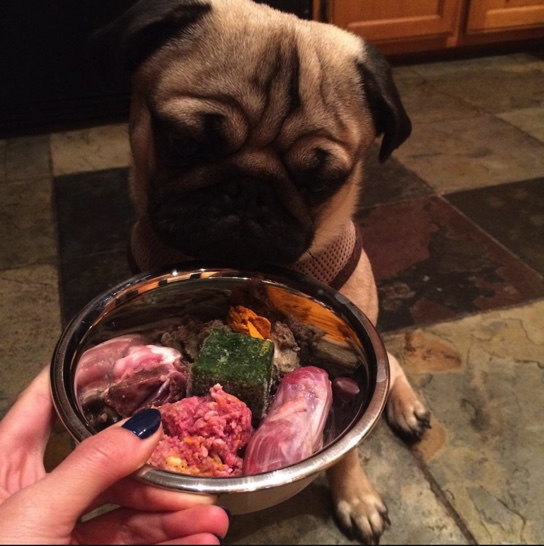Raw Food Made Simple
Must Have Calcium
Both dogs and growing puppies need enough calcium in their diet and they need some phosphorus to go with it because these minerals work closely together. Bones contain both calcium and phosphorus. On the other hand, meat is high in phosphorus and too low in calcium. About 1/3 of his diet should be nice meaty bones. Here are some good choices for meaty bones:
- Chicken wings, necks, legs or thighs
- Turkey necks (other bones are large)
- Beef tail bones (great for larger dogs)
- Lamb or goat necks or ribs
You can also feed your dog whole animals such as whole fish, whole rabbit and whole poultry. These contain just the right amount of bone. Raw eggs with the shell on also contain the right ratio of calcium and phosphorus (just be sure they’re from the farm. Grocery store eggs can sometimes have a toxic spray in their shells).
Organs Are The Multi-Vitamins
You’ll want to feed anywhere from 10% to 30% organ meats and this depends on how much you can get. If you can only find liver, just feed 10% organs, but if you’re lucky and you can find kidney, spleen, pancreas, brain and other delicious, nutritious organs, then feed them as a third of your dog’s diet. Never feed too much liver. Limit it to 10% of the diet because it’s really high in vitamin A and can give your dog diarrhea if you give too much. The same applies to any organ … no one organ should be more than 5% to 10% of your dog’s diet but if you have a few different ones, they can be 1/3 of your dog’s total meals.
Organs would include: Liver, kidney, spleen, pancreas, brain, lung, and testicles.
Just go easy on the organ meat at first because it can cause loose stools until your dog is used to all that nutrition. If your dog doesn’t like the taste at first, try frying it for a minute or so in a pan first.
Too Much Fat
Fat is healthy for your dog … it helps with nerve and immune function and is critical for skin health. But fat carries a downside … fat contains twice the number of calories as protein and it contains very few vitamins and minerals. Overall, you don’t want fat to be much more than 10% and certainly no more than 20% of the diet. This doesn’t mean no fat! Your dog needs fat, but just not so much of it that it robs him of other important nutrients.
High in Fat: Chicken neck with skin, pork belly, dark chicken or turkey meat with skin, and chicken neck with skin.
Low in Fat: Chicken neck without skin, rabbit, most fish, light chicken or turkey meat with no skin.
If you’re able to feed your dog whole fish, whole rabbit, or other whole animals with the bone in, they’re already balanced and you don’t need to add extra meat. If the carcass doesn’t have organs, be sure to add those back in.
Variety Counts
Just like us, dogs need a variety of wholesome foods to provide them with a wide range of nutrients. Not to mention the fact that it’s boring to eat the same foods every day! Feed a wide variety of different foods, including different sources of meat and don’t forget to feed some of the “weird and icky things” such as chicken, duck or turkey feet, beef trachea, tails, lung and testicles. Parts like beef trachea and poultry feet are loaded with natural chondroitin and glucosamine, which help to build healthy joints and they’re reasonably priced. So adding the icky parts is a win-win.
Benefits of Raw
Raw dog food diets are controversial, but the popularity of the diets which emphasize raw meat, bones, fruits, and vegetables is rising.
Benefits of Feeding Raw
- Shinier coats
- Healthier skin
- Cleaner teeth
- Digestion
- Higher energy levels
At the end of the day you should choose what diet works well for you and your pet!





